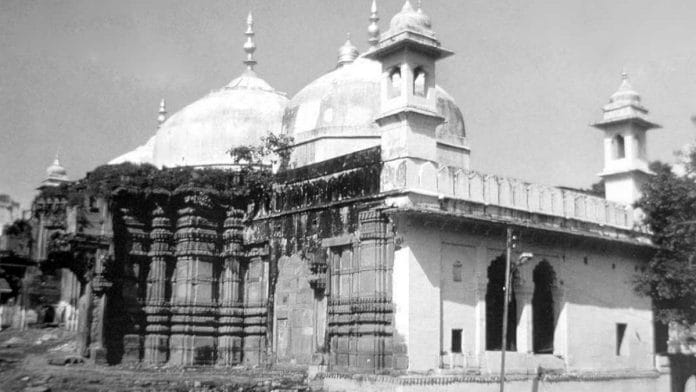Thank you dear subscribers, we are overwhelmed with your response.
Your Turn is a unique section from ThePrint featuring points of view from its subscribers. If you are a subscriber, have a point of view, please send it to us. If not, do subscribe here: https://theprint.in/subscribe/
One of the most significant judgments by the Allahabad High Court in the past year was the decision to permit prayers in the cellar of the Gyanvapi mosque. As expected, much of the discussion has centered on the rise of Hindu majoritarianism and the ongoing erosion of secular values across India. Rather than examining this issue from a moral or social perspective, let’s consider it through the lens of historical injustices. I understand that applying modern standards to historical events is challenging, but let’s explore how they might be thoughtfully applied by considering as many relevant factors as possible.
Since India’s independence, there have been numerous claims about the original nature of the Gyanvapi mosque. Some assert that no Hindu temple ever existed on the current site, while others contend that a temple once stood there, later replaced by a mosque after the original structure collapsed. Given India’s complex history under various rulers and their successors, discovering the complete truth may be impossible. Setting aside the debate over which claims are right or wrong, let’s focus on the findings from a survey by the Archaeological Survey of India (ASI), which concluded that a Hindu temple existed prior to the current mosque structure. While counterclaims about the motivations of the archaeologists conducting the survey may arise, we’ll address those separately. For now, let’s focus on how we can move forward with the findings and seek a resolution to the situation. Author Vikram Sampath believes that religious sites demolished by Muslim rulers should be returned to Hindus through mediation as an act of goodwill. In contrast, other scholars argue that the actions of historical rulers of Muslim faith are not the responsibility of present-day Muslims in India. In the current discourse, no one is blaming present-day Muslims for historical injustices. However, it is clear to many that Hindu organizations are using historical events and sites to settle scores and assert dominance, suggesting that “the shoe is on the other foot” now.
In the United States, efforts are being made to make amends for past wrongs, such as returning land that was unjustly taken from African Americans through racial discrimination during the Jim Crow era to their descendants. While these actions don’t undo the wrongs committed decades ago, they are essential to begin the healing process and help people move forward. When such measures are taken, there is no public outcry about reopening old wounds that have been buried. The situation in the USA cannot be directly compared to that in India, as in the former, the victim is the minority and the perpetrator is the majority. In such cases, it is clear that the actions were intended to intimidate a vulnerable group, unable to defend itself due to a lack of power. The situation in India is the opposite, where the rulers were a minority and the victims were the majority. In this situation, it appears that the current actions are driven by a desire for revenge, fueled by anger that has been simmering for too long. Let’s not forget that the partition of British India into India and Pakistan on religious grounds further complicates the issue, with the neighboring country constantly emphasizing its religiosity. The wounds of the violence that erupted during the partition are still vivid in people’s minds, and there are those who are still alive and have lived through this traumatic experience. During this time, Jawaharlal Nehru did the right thing but not opening further wounds in the nation by giving support to claims as to whether certain religious sites historically belonged to Hindu communities. Had religious disputes been allowed to gain a foothold in post-independence India, it could have led to civil war or the Balkanization of the country. Since the 2014 general election, many Hindu organizations have been emboldened by the newly elected government, and with its tacit support, they are vigorously pursuing legal action over religious sites, even those with the slightest claims. This ongoing turmoil threatens to open a Pandora’s Box, making it difficult to reverse the consequences in the years to come.
With history, social harmony, and national interests at stake, what can be done to address the concerns of all citizens in a way that prevents leaving behind smoldering embers that could ignite future conflicts? I will acknowledge that this is one of those issues where no solution is ideal. We could consider Vikram Sampath’s proposal of both communities coming together to resolve all issues amicably, with the Hindu side preparing a comprehensive list of sites that should be returned. Alternatively, we could adopt an approach similar to South Africa’s “Truth and Reconciliation Commission,” where an ombudsman gathers evidence about temples destroyed throughout history, allowing people to openly discuss the matter without fear of retribution. Another unconventional approach could be to draw from Hasan Suroor’s recent book Unmasking Indian Secularism, where India is declared a Hindu nation, similar to many constitutional monarchies in Europe, while still guaranteeing equal rights to all citizens, regardless of their faith. Regardless of the solution we choose, once an agreement is reached, we must extinguish the embers of historical wrongs and ensure they remain dormant for generations to come.
These pieces are being published as they have been received – they have not been edited/fact-checked by ThePrint.


